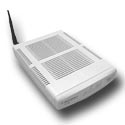The Wireless Future: Bluetooth and HomeRF in depth
by Matthew Witheiler on August 29, 2000 1:07 AM EST- Posted in
- Networking
HomeRF
Yet another wireless technology that is beginning to enter homes now is HomeRF. The HomeRF sessions proved to be crowded as well, meaning that there is definitely interest in both of these technologies.
 HomeRF
differs from Bluetooth because it was designed to solve a different problem
than Bluetooth targets. While Bluetooth serves to be more of a cable replacement,
HomeRF is about getting midrange wireless technology for network use. Able to
travel a distance of about 165 feet, HomeRF transmits at 2.4 GHz spectrum, putting
it right at the same operating frequency as Bluetooth. HomeRF is actually able
to get 1.6 Mb/s out of the frequency, making it a bit faster than Bluetooth.
HomeRF
differs from Bluetooth because it was designed to solve a different problem
than Bluetooth targets. While Bluetooth serves to be more of a cable replacement,
HomeRF is about getting midrange wireless technology for network use. Able to
travel a distance of about 165 feet, HomeRF transmits at 2.4 GHz spectrum, putting
it right at the same operating frequency as Bluetooth. HomeRF is actually able
to get 1.6 Mb/s out of the frequency, making it a bit faster than Bluetooth.
HomeRF has its origins in the 802.11 wireless internet protocol, as well as DECT voice technology, which means that HomeRF is capable of not only transmitting data packets but is also able to support up to 4 voice phones. Able to do this by dynamically allocating bandwidth to voice transfers, if necessary, HomeRF serves to wirelessly solve not only computing communication but all forms of communication in general. The system works with one device acting as a control box, sending out signals to other HomeRF devices in the area. This control box can be any HomeRF device and will typically be the first device installed in a HomeRF network. The control can send out packets that wake up other devices from a low power state, making them ready for communication. This allows many devices to use HomeRF, even ones that will remain idle for the majority of the time such as internet appliances. The majority of HomeRF devices will be laptops, desktops, printers, modems and such, serving to act as a personal home network.
 With
a range of 165 feet, the developers of HomeRF knew that other devices outside
of one PAN may interfere with other PANs. Take an apartment building, for example.
The vast majority of apartments will not span a sphere with a radius of 165
feet from a HomeRF source, meaning that HomeRF devices in one apartment could
potentially interfere with another apartment's HomeRF system. To prevent this
from happening, HomeRF incorporates a unique learn feature. Essentially what
this does is teach all existing and new HomeRF devices that the user defines
the information for the users PAN. This is done by placing one existing HomeRF
device to the "teach" mode and a second, new device to the "learn"
mode. This way, devices within a given area can only communicate with the HomeRF
devices that it has been taught, preventing conflicting Pans
With
a range of 165 feet, the developers of HomeRF knew that other devices outside
of one PAN may interfere with other PANs. Take an apartment building, for example.
The vast majority of apartments will not span a sphere with a radius of 165
feet from a HomeRF source, meaning that HomeRF devices in one apartment could
potentially interfere with another apartment's HomeRF system. To prevent this
from happening, HomeRF incorporates a unique learn feature. Essentially what
this does is teach all existing and new HomeRF devices that the user defines
the information for the users PAN. This is done by placing one existing HomeRF
device to the "teach" mode and a second, new device to the "learn"
mode. This way, devices within a given area can only communicate with the HomeRF
devices that it has been taught, preventing conflicting Pans
 A
few HomeRF based devices already exist now, such as the Intel AnyPoint wireless
home network and the Motorola AL 200 Multi-User Wireless Modem. With HomeRF
transmitter/receiver units running about $25 in parts and coming in a device
about the size of a compact flash card, HomeRF looks like it will not only be
rather cheap but also small. The $25 mark still makes the device too expensive
to be found in every laptop, however look for system integration to come in
higher end laptops. In addition, some low cost PC cards will be sold shortly,
allowing HomeRF technology to extend to many devices.
A
few HomeRF based devices already exist now, such as the Intel AnyPoint wireless
home network and the Motorola AL 200 Multi-User Wireless Modem. With HomeRF
transmitter/receiver units running about $25 in parts and coming in a device
about the size of a compact flash card, HomeRF looks like it will not only be
rather cheap but also small. The $25 mark still makes the device too expensive
to be found in every laptop, however look for system integration to come in
higher end laptops. In addition, some low cost PC cards will be sold shortly,
allowing HomeRF technology to extend to many devices.
One interesting thing that Dr. Kevin Negus of Proxim Inc. spoke to us about is HomeRF's ability to withstand interference from none other than the microwave oven found in 97% of homes. Dr. Negus stated that the 2.4 GHz radio frequency range is very susceptible to interference from a microwave oven, which throws out a myriad of frequencies into the air when it is operating. HomeRF is able to deal with the interference by altering the frequency at which it transmits; hopping which all but eliminates any data interference. In addition, each packet sent to a device on a HomeRF network must be acknowledged, so even if a a packet is lost due to interference, the sending device knows this and re-sends the lost packet before proceeding.










1 Comments
View All Comments
Dr AB - Saturday, May 9, 2020 - link
So HomeRF was actually prototype of Wi-Fi as we know of today .. Interference is still an issue to this day hopefully we will see Wi-Fi 6 soon & end this issue once and for all.